|
Albert
L. Kanter
- a biography from: |
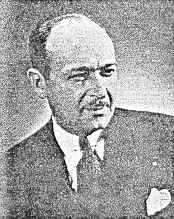
|
CURRENT BIOGRAPHY 1953
A modern and effective method of
arousing young students' interest in classical literature has been devised by Albert L.
Kanter, publisher of Classics, Illustrated, who began 10 publish comic-book
versions of famous novels in 1940. He is president of the Gilberton Company, Inc., which
now publishes and sells over a million copies each month.
In 1950 Kanter added Shakespeare's plays, and since that time over a million comic-strip
copies of Julius Caesar and half a million of Hamlet have been purchased by
school children. Each month 25.000 schools receive these "books," and teachers
use them as supplementary classroom aids.
Kanter has sold over 250,000,000 copies of his Classics, Illustrated comic books.
To date he has published 106 titles; Mutiny on the Bounty was the 100th title, and
the series included such stories as Treasure Island, Robinson Crusoe, David
Copperfield, Call of the Wild, The Last of the Mohicans, Arabian Nights, The
Deerslayer, Crime and Punishment, Two Years Before the Mast, and The Man
Without A Country.
Albert Lewis Kanter was born in Baranovitchi, Russia, on April 13, 1897, the son of Henry
and Ida (Mirsky) Kanter. His parents brought him and his two brothers to the United States
in 1904 and settled in Nashua, N.H. Kanter attended the public schools but, as he has
said, had no college education. Nevertheless, at an early age he became "a serious
student of literature, biography and history."
He obtained work at a textbook publishing house and went on the road through the New
England States as its sales representative. Later, he became associated with the Elliot
Publishing Company in New York City.
The first novel, Kanter adapted to the comic-book format and published was The Three
Musketeers. He printed 200,000 copies, which sold so well on the newsstands that he
followed it up with Ivanhoe. Teachers as well as school children demanded more.
Although some educators at first disliked the idea of condensing the great books and
presenting them with "balloons" and garish illustrations, many began to approve
of them as, at least, a way of introducing literature to the "un-literary".
Kanter noted during World War II that GI's liked comic books, and found a market for over
forty million copies of his comic-book versions of outstanding literature through Army
post exchanges and the American Red Cross. Thus classics were introduced to many soldiers
who had never read the full-length originals.
However, he became worried that school children, soldiers, and others who read comic books
would never experience the pleasure of reading the full-length novels on which the
abbreviated (but unexpurgated and unsimplified) comic versions were based, so he printed
this injunction at the end of each "story": "Now that you have read the Classics,
Illustrated edition, don't miss the added enjoyment of reading the original,
obtainable at your school or public library."
"I was pleased to note in letters from readers that many had followed this
advice," he said, recently.
Adapting a classic to comic book formula is a full-time publishing venture for Albert
Kanter.
"Ordinary comic books are turned out in a couple of weeks," he explained,
"but it takes anywhere from eight to fifteen months to prepare one classic. The
editorial board - which has its share of professors - meets four times a year to plan new
books. They assign a writer to adapt the story – that is, edit it to a point where it
can be illustrated in about 350 pictures.
"The editorial board adheres strictly to the original text when preparing a Classics
version," Kanter said. "A well-organized story continuity or narrative
explains the plot, but the characters speak only the words of the author, be he
Shakespeare, Dickens or Dostoyevsky." Artists with knowledge of the historical
backgrounds and authentic costumes are selected to produce the over 300 colored action
drawings for each book.
Acts of violence showing torture, or sadistic treatment, are omitted. If this has occurred
in the original plot, it is mentioned in the narration., but is not illustrated. Asked why
it was necessary to print the dialogue in balloon type, he explained that he was purposely
imitating the comic book style, and if he were to make literary, it would defeat its
purpose of "wooing youngsters to great books." He also includes a short biography of the author in each issue.
Kanter became an American citizen in 1907 through his father's naturalization papers, and
because he is proud of belonging to his adopted country, he includes in the back pages of
each issue of Classics Illustrated informative and educational articles
"stressing Americana and democracy at work." He also includes opera librettos,
biographies of pioneers in science, stories about American rivers, Indians, and other
historical topics.
Many teachers have written to Kanter stating that slow readers obtain help from the
pictures with words, the explanations and definitions of foreign or difficult words, and
the quizzes on famous literary characters, all designed to arouse their desire to read the
original works. As soon as a new edition of Classics Illustrated appears,
librarians report that "tere is a run on the original title".
This experiment in publishing proved so successful in the United States that now Classics
Illustrated are translated in twelve foreign languages. Despite paper shortages and
rising costs of production, he has managed to keep the price for each issue at ten cents,
and fifteen cents abroad.
When Kanter's version of Julius Caesar appeared in 1950, after months of research
in cooperation with New York University, there was considerable editorial comment in the
nation's press. The Newark (N.J.) Evening News commented: "A 20-man editorial
staff has been at work on Julius Caesar ... in comic
book form. This concept of ministering on a high plane to youthful desire for action
pictures ... deserves to succeed."
The New York Times (March 9, 1950) stated "Via the 'balloons' of a new series
of multicolored books, the tragedies of William Shakespeare will begin an ascension to the
level of 'must' reading for millions of comic book fans in this country and abroad ...
Selections from the Great Bard's classic verse in Julius Caesar will be matched
with 320 brightly colored action drawings. According to Albert L. Kanter, president of the
Gilberton Company, which publishes the books, this is the first time that anyone has tried
to put Shakespeare into the popular juvenile form." The Chrisian Science Monitor (March
13, 1950) commented: "Et tu, comic books? Yes, the comics have caught up with
Shakespeare. A comic publisher offers a 10-cent illustrated version of Julius Caesar."
The St. Paul, (Minn.) Dispatch commented on the Julius Caesar comic
book: "This may be at last the sort of adventure story the grade school pupil will no
longer have to hide behind his geography book." The Julius Caesar book was
translated into French, Spanish, Portuguese, Italian, Chinese, Afrikaans, Hebrew,
Hindustani and Tagalog, the language of a large part of the Philippines. As in the case of
other literary classics that his concern has published since 1940, Kanter printed
Julius Caesar abroad in those areas where currency restrictions prevent dollar
imports. The printing is done by means of "mats" which are sent from the United
States by airmail.
The Parkersburg, West Virginia, News commented editorially on November 6, 1951, on
Classics Illustrated: "We were gratified recently, to find on sale in the
five-and-ten stores here a veritable library of the classics - done in true comic book
style, with plenty of color and pictures. For this inestimable boon to childhood, you have
to thank the ingenuity and enterprise of the Gilberton Company ... While we believe all
lovers of good books might prefer the standard book issues, which, however might cost as
much as $1 or $2 or even $3 each - beyond the reach of many families - nevertheless the
comic book classics, we believe, will fill a long-felt want.
Children who otherwise might never know of these classics will get an opportunity to delve
into this treasure house of the great masters of literature."
Following the success of Julius Caesar, Kanter published A Midsummer Night's
Dream, Homer's Odyssey and Shakespeare's Hamlet, each of which
sold half a million copies.
The publisher was married on December 17, 1917, to Rose Ehrenrich, and they have two sons,
Hal and William, and one daughter, Saralee Emerson. Among his clubs are the Knights of
Pythias, Masons and Scottish Rite. Kanter has also been an active worker in behalf of the
United Jewish Appeal and the Israel Bond Drive. His political affiliation is Republican.
He has blue eyes and brown hair, is six feet tall, and weighs 190 pounds. His hobbies are
golf and horseback riding.
Seventy-five per cent of the countries of the world buy American comic books, declared
Kanter, but Russia and Iron Curtain Countries are not among these. Sixty per cent of
Classics Illustrated are purchased by boys; the average age is thirteen. The most
popular in the series have been The Three Musketeers and Julius Caesar.
The stories selected for comic-book versions in 1953 include Bring 'Em Back Alive by
Frank Buck; From the Earth to the Moon by Jules Verne; Knights of the Round
Table; Pitcairn Island by Nordhoff and Hall; A Study in Scarlet by Sir
A. Conan Doyle; The Talisman by Sir Walter Scott; Kit Carson based on
biographical and historical records; The Forty-Five Guardsmen by Alexandre Dumas,
and The Red Rover by James Fenimore Cooper.
References
Christian Sci Mon Mr 13 '50
N Y Herald Tribune Mr 12 '50
N Y Times Mr 9 '50
Kanter biography in Danish Illustrerede Klassikere nr.65
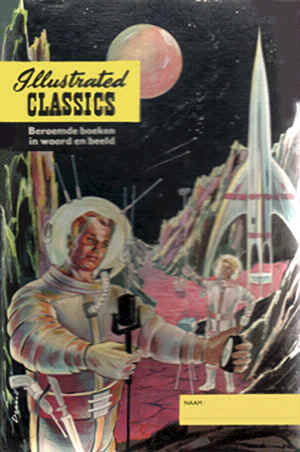
Dutch portfolio for 10 issues of Illustrated
Classics
|
|
As
Kantner told, in 1953 Classics
Illustrated had been tranlated into
French, Spanish, Portuguese, Italian,
Chinese, Afrikaans, Hebrew, Hindustani
and Tagalog, the language of a large part
of the Philippines. From 1955 to 1966
149 Gilberton classics was published in
Danish, but more than 20 countries
- among them Norway, Iceland, Greece,
Netherlands and even Czechoslovakia -
was introduced to Classics Illustrated
in their native languages.
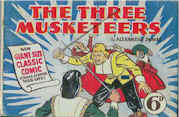
The first foreign publication
was the Australian edition,
running 1947-53.
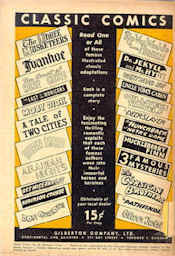
The second foreign publication
was the Canadian edition, beginning
with #10, Robinson Crusoe, in 1948
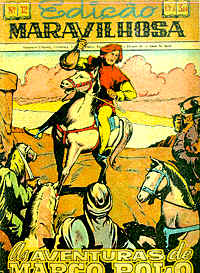
Edicao Maravilhosa - the
Portuguese translation of
Classics Illustrated -
published in Brazil.
#1 appeared in July 1948.

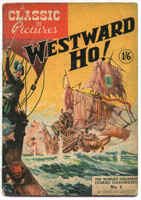 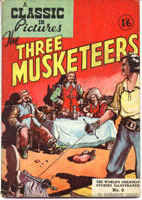
The first British edition was A Classic in Pictures. Later published as Classics
Illustrated.
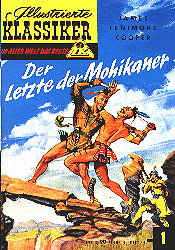
1952-53 8 issues
of Classics
Illustrated was published in
Germany. #1 was The Last
of the Mohicans. 1956-72
206 issues appeared in
German language. #1 was
Alice in Wunderland.
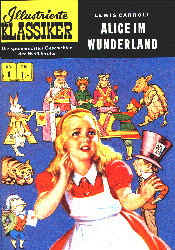
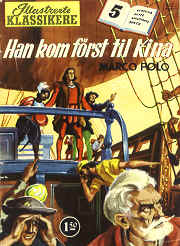
The Norwegian #5 from 1955.
# 1 was published in 1954. All
of them had European covers

The Danish edition,
published 1955-76

The Swedish edition,
published 1956-76 -
and following the Danish

The Icelandic #12
from 1955 - following
the Danish publication.
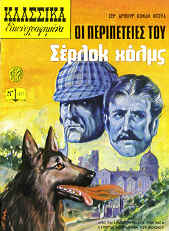
The Greek version of
Classics Illustrated #33
with European front cover
and inside splash-cover by
Henry C. Kiefer. All other
inside art by Louis Zansky
The
Dutch version of Illustrated Classics
- here Op jacht naar het avontuur (#119)
by Kurt Schaffenberger and
De Partizanenleider (Gøngehøvdingen)
by Swedish artist Göta Göransson. |